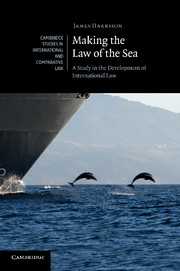Book contents
- Frontmatter
- Contents
- Acknowledgements
- Table of treaties
- Table of cases
- Abbreviations
- 1 Making the modern law of the sea: challenges and opportunities
- 2 The United Nations Convention on the Law of the Sea
- 3 Amendment and modification of the Law of the Sea Convention by the States Parties
- 4 Implementing agreements
- 5 Developments in the deep seabed mining regime
- 6 The International Maritime Organization and the international regulation of shipping
- 7 The contribution of the Food and Agriculture Organization to international fisheries law
- 8 Cooperation, coordination and conflict between international institutions
- 9 Conclusion
- Bibliography
- Index
- CAMBRIDGE STUDIES IN INTERNATIONAL AND COMPARATIVE LAW
3 - Amendment and modification of the Law of the Sea Convention by the States Parties
Published online by Cambridge University Press: 03 May 2011
- Frontmatter
- Contents
- Acknowledgements
- Table of treaties
- Table of cases
- Abbreviations
- 1 Making the modern law of the sea: challenges and opportunities
- 2 The United Nations Convention on the Law of the Sea
- 3 Amendment and modification of the Law of the Sea Convention by the States Parties
- 4 Implementing agreements
- 5 Developments in the deep seabed mining regime
- 6 The International Maritime Organization and the international regulation of shipping
- 7 The contribution of the Food and Agriculture Organization to international fisheries law
- 8 Cooperation, coordination and conflict between international institutions
- 9 Conclusion
- Bibliography
- Index
- CAMBRIDGE STUDIES IN INTERNATIONAL AND COMPARATIVE LAW
Summary
Introduction
The drafters of the Law of the Sea Convention were aware that if the Convention was to provide an enduring legal framework, it must be able to evolve to take into account legal, political, scientific and technological developments. At the closing session of UNCLOS III, the delegate from Sri Lanka summed up the transience of the Convention framework in the following words:
It is in the nature of all things that they do not remain static, that there will be growth and there will be decay. The march of technology and changing perceptions and aspirations will, in time, place pressures upon the regimes we establish today.
The purpose of this chapter is to consider the formal and informal mechanisms for the review of the law of the sea regime and the making of amendments or modifications thereto.
The need for some institutional means through which measures could be taken to implement and develop the Law of the Sea Convention was discussed by UNCLOS III on a number of occasions. The issue was raised at an early stage by the UN Secretary-General in a speech to the second session of the Conference, when he highlighted to delegates that “inevitably … the international community would continue to evolve and its uses of the sea would continue to develop and diversify.” The Secretary-General went on to advocate that “the Conference … might well consider whether some institutional means should be created whereby, within the framework of the new convention, common measures could be agreed upon and taken whenever necessary so as to avoid obsolescence under changing world conditions.”
- Type
- Chapter
- Information
- Making the Law of the SeaA Study in the Development of International Law, pp. 62 - 84Publisher: Cambridge University PressPrint publication year: 2011

